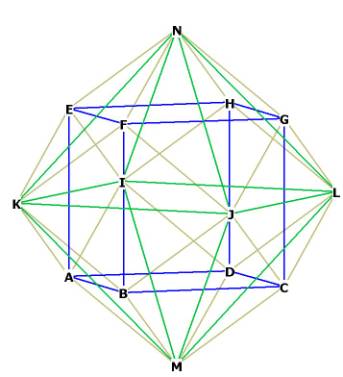|
(2017
midterm assignment) Model Student Midterm answers 2017 (Index) Essay 1: Compare, contrast, and evaluate Narratives of the Future |
 |
Sarah
Nava
November 6, 2017
Working Together to Find a Future
While studying various future narratives it has become apparent that it
is difficult to have one definitive type of story line without also having
elements of others. The three main types of story lines, apocalyptic,
evolutionary and alternative, seem to converge often among future narratives and
blend together to create visionary tales of what lies ahead. For example. while
all stories have a beginning and an end, which hints at an apocalyptic story
line, most stories seem to have some type of cyclical pattern of ups and downs
to get there, which suggest an evolutionary story line. Some stories can have
both of these elements from apocalyptic and evolutionary as well as some
alternative future traits where many time lines are occurring at the same time.
An
apocalyptic story line is characterized by a linear path that occurs within an
easily imaginable period of time, such as hundreds or thousands of years, or
less. A great example of an apocalyptic story line is The Bible, where
everything begins exceptionally well with the creation of the earth, the sun,
the moon, people, plants and animals and ends in a fiery brimstone that ends the
earth and focuses on a new beginning in their utopia in Heaven. Clearly, from
Genesis to Revelation there is the beginning of the existence of Earth, but also
its end. A seemingly straight line from creation to doom. However, after Earth
is created the story quickly takes a downward spiral with the introduction of
the antagonist serpent. Once Adam and Eve come to terms with their new life and
have children the story continues on and on with many successes and tragedies
before reaching the time of the apocalypse. Genesis and Revelation do have a
beginning and an end, but the stories are also full of celebrations, mild
dilemmas, severe tragedies and many other types of scenarios and situations that
create a cyclical journey through time with an untold version of what may have
happened after the apocalypse. In this way, The Bible also involves an
evolutionary story line.
The
evolutionary story line exists along a much larger scale of time, which can
include millions or billions of years, or more. It presents a cycle of growth
that is consistent throughout the story. In Octavia Butler’s
Parable of the Sower, the reader
enters into an evolutionary time line where people are struggling to survive.
Throughout the narrative the time line is made known to offer a beginning to the
current situation as the characters try to find their way back to some type of
normal. There is a clear low-tech dystopia playing out throughout the text. As
the story progresses to the end many ups and downs are involved with attacks,
survival and the development of a new group to create a post-apocalyptic
community. However, the reader is not left with a novel full of deceased
characters nor a successful, safe new world. Instead we are left with the eerie
reminder that when people appear to have things worth taking they will be
attacked and left “with scraps of their belongings on their backs” (Butler,
p.228). Parable of the Sower leaves
its readers with many questions, but due to its cyclical pattern, it might be
safe to assume that Lauren’s group will see more of the same in their future.
Another example of an evolutionary narrative is “Stone Lives”. This short story
by Paul Di Filippo seems to have a dystopia among a utopia. It also shows how a
character might learn from one lifestyle to help with the other. As Stone learns
to survive without sight, the reader gets to journey along with him as he learns
how to see. The vision portrayed by Filippo allows the audience to fear, grow,
have pride, and lose what was just gained, Stone’s family, with true emotion.
The story is one of survival and the emotional toll is also very continuous.
Along the same lines, “Bear Discovers Fire” by Terry Bisson is another short
story where bears evolve instead of humans. I suppose the humans evolve as well
as they learn to accept bears camping out nearby as normal everyday bear
behavior. The bears adapted right out of their hibernating habits, because bears
with fire can keep warm during the cold winter months. This low-tech narrative
was somewhat unclear where it was heading, as some people wanted to hunt the
bears and others wanted to live among them. Hopefully this ecotopia doesn’t
evolve into a dystopia.
The
third type of future narratives is alternative futures. This story line varies
in every way. It might branch, it might have several lines running parallel or
perpendicular and it might change depending on occurring factors. A great
example of this is William Gibson’s “Garden of Forking Paths”. This short story
emulates how alternative futures work with multiple time lines that have
differing outcomes which all occur in different spaces of existence. “Mozart in
Mirrorshades” by Bruce Sterling and Lewis Shiner illustrates another example of
an alternative future tale by expanding on wormholes and time travel. With
mentions of Marie Antoinette and Mozart the reader journeys back in history only
to find the future there. This narrative shows how time travel can affect other
timelines, mostly negatively. In yet another future narrative,
The Time Machine by H.G. Wells
develops an imaginative creation of what the far future might look like. In this
novel, like in “Stone Lives”, we see a utopia among a dystopia. It appears that
some beings have evolved to survive, each in different ways. One group lives in
light and the other among darkness. This novel is a bit more complex as it shows
signs of an apocalyptic timeline, but also an evolutionary time line. For
example, the time traveller only seems to travel in a linear line. There are no
turns or directions, only forward and back. It also shows different creatures
during different eras as evolved beings as they try to survive the changes that
seem to be overtaking the earth.
I,
admittedly, appreciate apocalyptic and evolutionary narratives as they are more
familiar to me and more relatable. While high-tech tales of time machines and
robots are manageable, I struggle to envision creatures and objects that don’t
exist at this time. Once a story dives too deep beyond my reality I lose track
and I lose interest. I believe this is why cyberpunk has a following of very
distinct fans. Most readers need to be able to make a connection with their text
to be able to enjoy it. Overall, future narratives show a true reflection of the
future in the sense that we have no idea what is coming, how it works, or what
else may exist. Good luck to all of us!
 |
 |
 |
